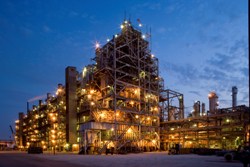US shale boom lifts petrochemical exports - report
 The US shale gas exploration and production boom continues to fuel significant cost advantages for North American commodity chemicals producers as relative costs of natural gas and oil-based feedstocks remain far apart, according to a new report from credit-watch firm Fitch Ratings.
The US shale gas exploration and production boom continues to fuel significant cost advantages for North American commodity chemicals producers as relative costs of natural gas and oil-based feedstocks remain far apart, according to a new report from credit-watch firm Fitch Ratings.
Fitch said it sees the increased availability of cheap natural gas liquids (NGL) feedstocks as a critical factor supporting the competitive position of North American commodity chemicals firms by pushing them down the cost curve versus global competitors.
Innovation in drilling technology, including widespread use of horizontal drilling and hydraulic fracturing ('fracking') has sharply boosted liquids supply from unconventional shales in North America, in turn pressuring prices of North American NGLs.
Meanwhile, upstream exploration and production (E&P) companies such as Marathon Oil, Occidental Petroleum, and Conoco Phillips have directed more capital expenditures to onshore liquids-rich shale plays in the US and Canada, paving the way for further supply growth.
For downstream producers of petrochemicals and plastics, access to lower-cost NGL feedstocks has boosted export competitiveness in products such as ethylene, polyethylene (PE), and other derivative products.
European producers, in contrast, which rely on heavier crude oil-based feedstocks such as naptha and vacuum gas oil (VGO), continue to see a feedstock cost disadvantage.
Since 2008, light feedstock (ethane) prices as a percentage of Brent crude oil have declined from approximately 43% to 27% at current market prices.
In response to these favorable input cost shifts, companies such as Dow Chemical, Chevron, Westlake Chemical, and Nova Chemicals have announced major expansions of North American nameplate petrochemical production capacity, including various ethylene cracker projects.
In addition to expansions along the Gulf Coast, Shell Chemical has announced plans to build a facility in West Virginia, near the Marcellus shale in the Appalachians.
'The surge in shale liquids availability has been a game-changing event for downstream chemical producers dependent on inexpensive light feedstocks,' says Mark Sadeghian, senior director in Fitch's corporate finance group.
Unconventional gas resources now account for approximately 25% of North American natural gas supplies, and that share is likely to grow significantly in coming years, Fitch said.
The surge in shale gas availability has contributed to a halving of natural gas prices in the US compared with three years ago, when unconventional gas exploration began to accelerate.
Despite growing signs of a global slowdown and reduced growth rates in Asian export markets, North American chemical producers may still benefit materially from the shale gas revolution, with the differential between gas and oil-based feedstocks likely to remain at historically wide levels over the near to medium term.
Further information can be found at the Fitch website by clicking here.






Comments